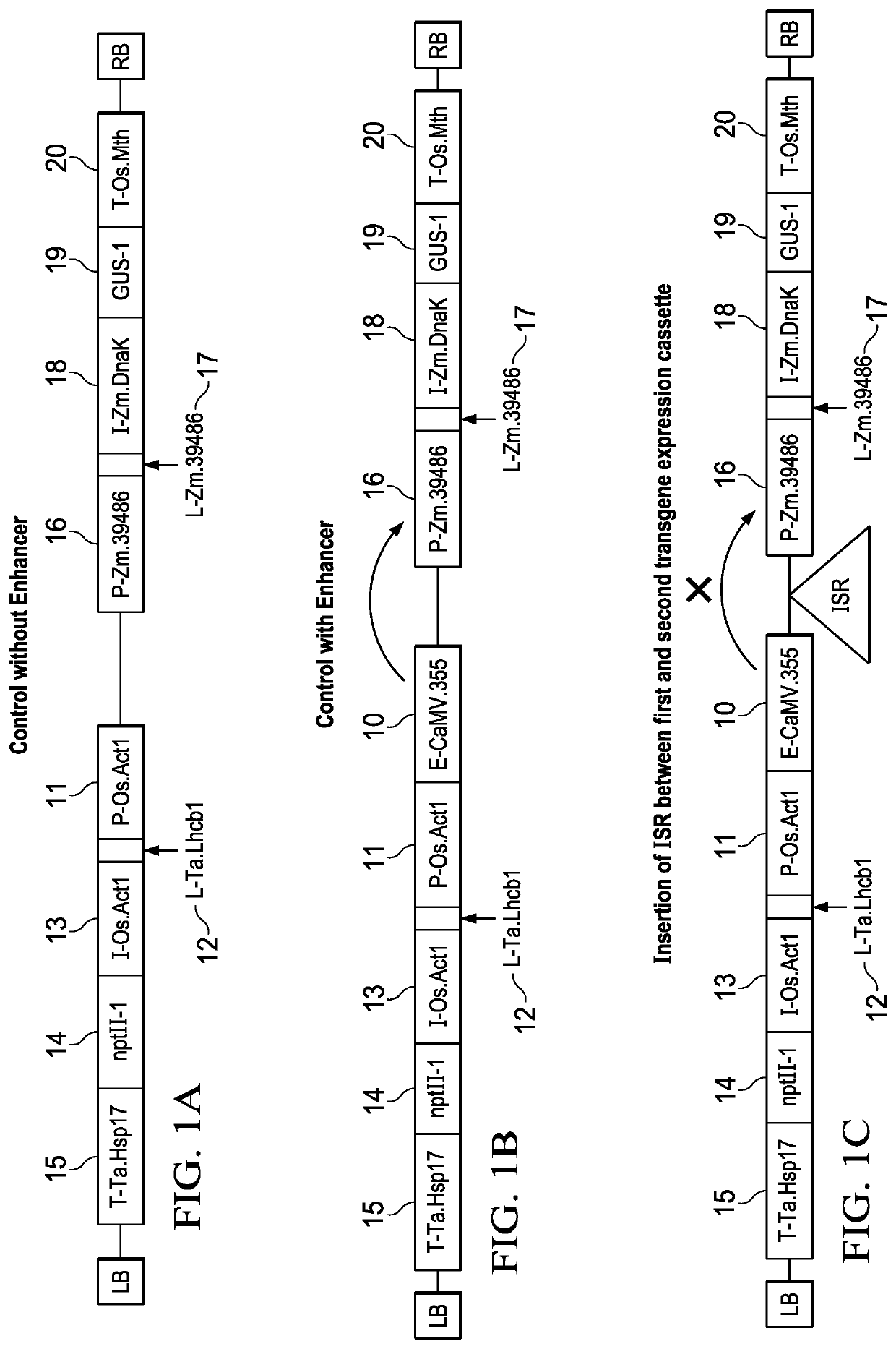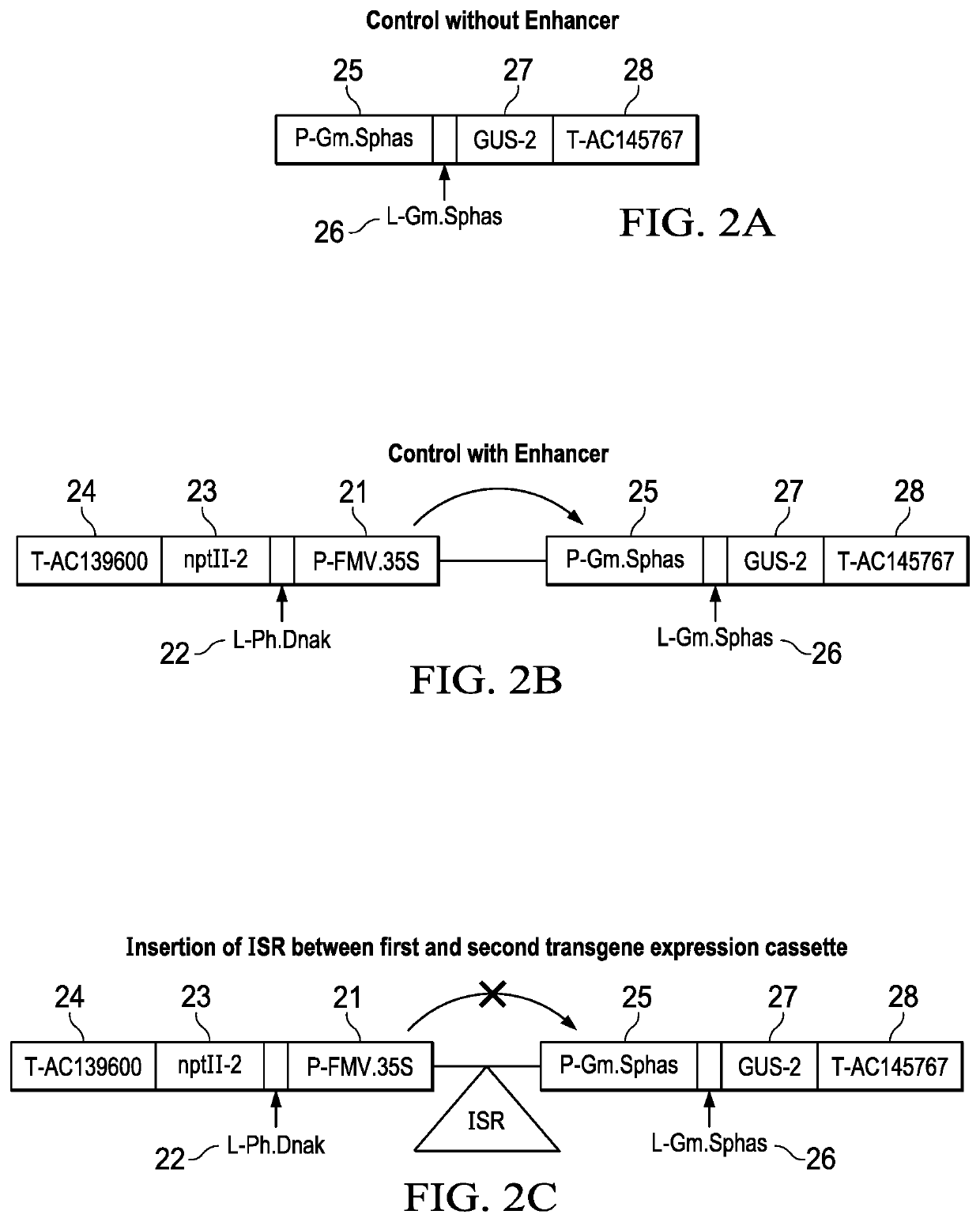Intergenic sequence regions and uses thereof
a technology of intergenic sequence regions and dna molecules, which is applied in the field of plant molecular biology and plant genetic engineering, can solve the problem of negative affecting the intended phenotype of seed-specific expression cassettes
- Summary
- Abstract
- Description
- Claims
- Application Information
AI Technical Summary
Benefits of technology
Problems solved by technology
Method used
Image
Examples
example 1
Design, Synthesis, and Cloning of the Intergenic Sequence Region Elements
[0093]Synthetic Intergenic Sequence Region elements (“ISRs”) were computationally-designed through algorithmic methods. Each ISR was designed to not contain any potential Open Reading Frames (ORF) that could inadvertently lead to the production of unwanted proteins after insertion into the plant genome. In addition, many of the ISRs were designed to contain stop codons at the 5′ and 3′ ends of the ISR, positioned in a manner to provide stop codons in all six reading frames.
[0094]Once designed, the ISRs were chemically synthesized and cloned between transgene expression cassettes in a heterologous vector stack. Well over 100 synthetic Intergenic Sequence Region elements were designed and assayed in stably transformed corn and soybean plants to identify those synthetic ISRs that reduced the interaction of a first transgene cassette with a second transgene cassette.
[0095]Certain designed and tested ISRs are presen...
example 2
Reduction of Transgene Expression Cassette Interaction by ISR4_Stop, ISR89, and ISR97 in Stably Transformed Corn Plants
[0098]This Example demonstrates the ability of the ISRs ISR4_Stop, ISR89, and ISR97 to reduce transgene expression cassette interaction when inserted between a first transgene expression cassette and a second transgene expression cassette of a vector stack used to stably transform corn plants.
[0099]Corn plants were transformed with binary plant transformation vector stacks comprising two transgene expression cassettes in divergent orientation with an ISR between the two transgene expression cassettes to assess the ability of the ISR to reduce transgene expression cassette interaction. Two control vector stacks were also transformed into corn plants and tested.
[0100]One control vector stack (FIG. 1a, Control without Enhancer) comprised a first transgene expression cassette which comprised a promoter, P-Os.Act1:67 (SEQ ID NO:11), operably linked 5′ to a leader, L-Ta.L...
example 3
Reduction of Transgene Expression Cassette Interaction by ISR2 and ISR4 in Stably Transformed Soybean Plants
[0110]This Example demonstrates the ability of the Intergenic Sequence Region elements, ISR2 and ISR4 to reduce transgene expression cassette interaction when inserted between a first transgene expression cassette and a second transgene expression cassette of a vector stack used to stably transform soybean plants.
[0111]Soybean plants were transformed with binary plant transformation vector stacks comprising two transgene expression cassettes in divergent orientation with an ISR between the two transgene expression cassettes to assess the ability of the ISR to reduce transgene expression cassette interaction. Two control vector stacks were also transformed into soy plants and tested.
[0112]One control vector stack (FIG. 2a, Control without Enhancer) comprised a single transgene expression cassette comprised of a seed-specific promoter, P-Gm.Sphas1:14 (SEQ ID NO:25), operably lin...
PUM
| Property | Measurement | Unit |
|---|---|---|
| Structure | aaaaa | aaaaa |
| antibiotic resistance | aaaaa | aaaaa |
| compositions | aaaaa | aaaaa |
Abstract
Description
Claims
Application Information
 Login to View More
Login to View More - R&D
- Intellectual Property
- Life Sciences
- Materials
- Tech Scout
- Unparalleled Data Quality
- Higher Quality Content
- 60% Fewer Hallucinations
Browse by: Latest US Patents, China's latest patents, Technical Efficacy Thesaurus, Application Domain, Technology Topic, Popular Technical Reports.
© 2025 PatSnap. All rights reserved.Legal|Privacy policy|Modern Slavery Act Transparency Statement|Sitemap|About US| Contact US: help@patsnap.com


